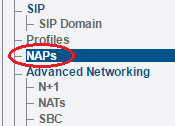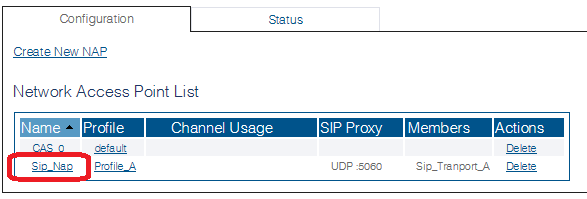Toolpack:Associate Local NAT to NAP
From TBwiki
(Difference between revisions)
(grammatical corrections for #4 and #5) |
|||
| (4 intermediate revisions by one user not shown) | |||
| Line 1: | Line 1: | ||
{{DISPLAYTITLE:SIP Configuration for Local Symmetric NAT Traversal}} | {{DISPLAYTITLE:SIP Configuration for Local Symmetric NAT Traversal}} | ||
| − | == | + | {| class="wikitable" |
| − | + | |- | |
| + | |rowspan="3"|This article applies to: | ||
| + | |'''Product''' | ||
| + | |'''Version''' | ||
| + | |- | ||
| + | |Tmedia | ||
| + | |3.0, 3.2 | ||
| + | |- | ||
| + | |SBC | ||
| + | |3.1 | ||
| + | |} | ||
| + | |||
| + | It is assumed, that a [[Toolpack:Allocating_a_SIP_Network_Access_Point_(NAP)_SBC_A|SIP NAP]] or a [[Toolpack:Allocating_a_SIP_Open_Network_Access_Point_(NAP)_SBC_A|SIP Open NAP]] has already been created and is allocated. <br /> | ||
<br /> | <br /> | ||
== To configure a Local Symmetric NAT Traversal == | == To configure a Local Symmetric NAT Traversal == | ||
| Line 11: | Line 23: | ||
[[File:EnableSipISipT_1.png]]<br /><br /> | [[File:EnableSipISipT_1.png]]<br /><br /> | ||
| − | 3. Click | + | 3. Click '''Network Address Translation (NAT)''':<br /> |
[[File:Configuring_remote_or_local_nat_traversal.jpg|500px]]<br /><br /> | [[File:Configuring_remote_or_local_nat_traversal.jpg|500px]]<br /><br /> | ||
| Line 29: | Line 41: | ||
[[File:selecting_local_method_for_sip_nat_traversal.jpg|900px]]<br /><br /> | [[File:selecting_local_method_for_sip_nat_traversal.jpg|900px]]<br /><br /> | ||
| − | 6. Click | + | 6. Click '''Save'''. |
| − | + | ||
| − | + | ||
| − | + | ||
Latest revision as of 15:36, 24 November 2020
| This article applies to: | Product | Version |
| Tmedia | 3.0, 3.2 | |
| SBC | 3.1 |
It is assumed, that a SIP NAP or a SIP Open NAP has already been created and is allocated.
To configure a Local Symmetric NAT Traversal
1. Select NAPs in the Navigation Panel:

2. Select an existing SIP NAP in the list:

3. Click Network Address Translation (NAT):

4. We assume that a local NAT has been created and allocated. SBC/Tmedia can be configured for RTP messages traversing a local NAT as follows:
- No NAT: SBC/Tmedia is not behind a NAT for RTP messages.
- Existing [Local NAT name] item: local NAT name that will be used for the local RTP traversal method.
Select the appropriate method for RTP NAT Traversal.
5. We assume that a local NAT has been created and allocated. SBC/Tmedia can be configured for SIP messages traversing a local NAT as follows:
- No NAT: SBC/Tmedia is not behind a NAT for SIP messages.
- Existing [Local NAT name] item: local NAT name that will be used for the local SIP traversal method.
Select the appropriate method for SIP NAT traversal.
6. Click Save.

